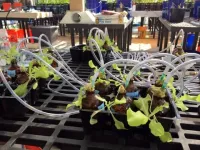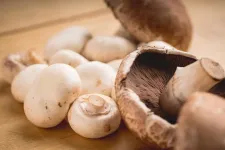By themselves, bones seem somewhat uniform to the untrained eye. They lack the traits we so often use to categorize fellow humans: hair texture, the shape of nose and eye, skin pigmentation.
Forensic anthropologists know that race isn't based in biological fact, but in a history and culture that assigns meaning to physical traits that occur among different human populations. Why, then, are they still relying on a tool from the field's negative roots in "race science"?
Binghamton University Associate Professor of Anthropology Elizabeth DiGangi addresses this issue in a recent article in The American Journal of Physical Anthropology. Co-authored with Jonathan Bethard of the University of South Florida, "Uncloaking a Lost Cause: Decolonizing ancestry estimation in the United States" explores a practice that dates back to the very origins of forensic anthropology in the late 19th and early 20th centuries.
The field was initially created by anatomists who had human skeletons in their museums or medical schools; they began studying the bones to see what could be learned from their features. Ancestry estimation, which analyzes bone structures -- especially those in the face or skull -- to determine ancestral origin was among the early developments.
However, the practice was originally anything but neutral: scientists used these features to classify races they had already arbitrarily defined, with the goal of proving the superiority of European men. It should be noted, DiGangi said, that these scientists were all European men themselves.
When forensic anthropology became formalized later in the 20th century, it kept the practice of ancestry estimation.
"Since the time of professionalization of the field in the late 1970s, we've just taken as fact that ancestry estimation could and should be done," she said.
Social vs. biological race
The categories we're all familiar with from census forms to employment applications -- African-American/Black, European-American/white, Asian-American and so forth -- are examples of social race. These categories are not only a human creation, but they have changed through the years based on government priorities and social sentiment. In the early 20th century, for example, Irish and Italian immigrants weren't considered white, although they are today.
"Biological race is the myth that there is something inherently biological about the differences between these constructed groups, that the human species is divided into races. This myth has been debunked for decades," DiGangi said. "The problem is that science was responsible for teaching the world that biological race was real, yet has not fully succeeded at rescinding it, explaining why we were wrong and atoning for the gross miscommunication."
These concepts can influence how we interpret otherwise neutral phenomena, such as bones. Like any other part of the body, bones have subtle variations from individual to individual, such as the precise location of a hole where a nerve passes through or a roughened area for a muscle attachment. Ancestry estimation particularly relies on skull features and the bones that make up the face, known as morphoscopic traits.
It has long been assumed that morphoscopic traits indicate a person's ancestry, and there has been some research into specific feature variations among different human groups. However, research has never determined the extent to which these features are inherited, making their connection to particular groups largely anecdotal, DiGangi explained. There are other problems, too: If you were to study whether these traits could be inherited, how do you determine the demarcation line between different groups?
In other words, ancestry estimation isn't grounded in good science.
Those defending its use, however, say that it's a needed tool. In the United States' complex system of death investigation, forensic anthropologists work alongside law enforcement when it comes to identifying human remains. The morphoscopic traits, dental traits and skull measurements that underpin ancestry estimation would be meaningless to investigators unless they can be mapped onto social racial categories.
But it's hard to say whether ancestry estimation really helps identify people, the authors point out. Estimates tend to rely on cases where a body is successfully identified -- and don't take the failures into account.
And then there is also the troublesome legacy of white supremacy that underpins policing in the United States. In the paper, the authors hypothesized that racial bias on the part of the investigators could lead to delayed or nonexistent identification for people of color, and issued an urgent call for research.
"People in the forensic sciences have a tendency to think that because we work for justice for victims, we are above the fray and racism is not applicable to us or the institutions we work for," DiGangi said. "As far as I'm concerned, it's well past time for a reality check."
Changing a culture of exclusion
Today, the discipline once created by white anatomists is called biological anthropology, partially to distinguish it from its earlier racist roots. We shouldn't forget that history, but instead "own it and actively atone for it, which includes ensuring that the discipline is more equitable and inclusive," DiGangi explained.
Biological anthropology has made some progress in this area, but forensic anthropology, a subset of that larger field, hasn't done the same.
Today, 87% of forensic anthropologists are white and DiGangi is a rarity. In fact, she's the only board-certified person who has identified as Black in the history of the American Board of Forensic Anthropology, which was established in 1977.
While diversity is sorely needed, it has to be more than just a buzz phrase. Concrete actions need to be taken not only on the board level, but in anthropology departments, student organizations, and undergraduate and graduate mentoring relationships, all of which lead future forensic anthropologists to the discipline.
These actions include increasing transparency and atoning for the past and present harms done to a variety of populations: people of color, women, the LGBTQ+ community and those who aren't able-bodied or neurotypical. One of those harms is a history of exclusion.
"Leadership may think that they are not exclusionary, but any organization whose membership consists overwhelmingly of white people is exclusionary, and the organization and its members have a responsibility to figure out the factors that have led to that and fix it," she said.
Organizations need specific policies and procedures to create a welcoming environment. Think of a typical summertime barbecue: no one is going to invite themselves in, especially if the other attendees don't look like them and the food and music are otherwise unfamiliar, DiGangi said. But if the barbecue attendees are welcoming, engage with that new individual, make adjustments to meet their needs and truly listen, the situation changes.
This isn't an issue unique to forensic anthropology.
"All of the sciences, and certainly the other forensic disciplines, need to face the issue of how racism and other forms of discrimination have been a key force in everything from our membership recruitment and retention to our methods and how we interpret the results," she said.
INFORMATION:

